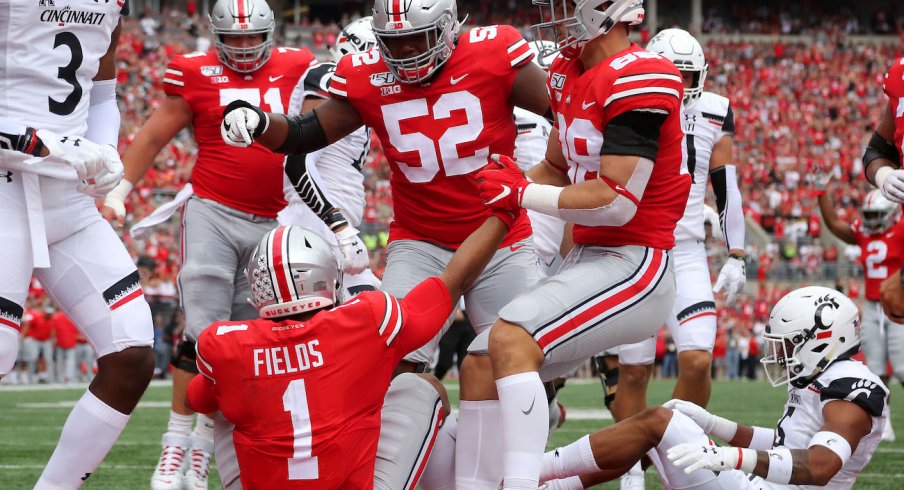At long last, the Battle of Ohio is over.
The Cincinnati Bearcats took the trek up I-71 for the first time since Ohio State's National Championship winning season. The Buckeyes controlled the game from start to finish, winning 42-0 and allowing just 273 yards of total offense. It was Cincinnati's first shutout loss since 2005.
In today's Three Key Stats, we'll look at the difference in pass protection, Ohio State's big plays, and how the Bucks efficiency on first down helped them stay ahead of the chains and control the game.
Ohio State sacked Desmond Ridder five times. Justin Fields was sacked just once.
After their bout against Florida Atlantic, it was obvious that the offensive line was the unit that needed to improve the most. The Bucks allowed two sacks and two hurries against a bad Owls defense.
This week, against a defense that finished last year in the top five in total defense, the offensive line stepped it up, allowing just a single sack and no hurries. While there still may be work to be done with this unit, their performance in pass protection and run blocking (Ohio State averaged 5.9 yards per rush) against a solid defense is more than commendable.
On the defensive side, the Rushmen simply got after it. Tyreke Smith recorded his first career sack, Chase Young was in the backfield for 1.5 sacks and Brendon White added another one. Even defensive back Shaun Wade, who had arguably the most complete game of his young career, was able to sack Ridder.
In all, the Buckeyes sacked Cincinnati five times and allowed just one on the other side of the ball.
Ohio State had 11 big plays, propelling its offense to 508 yards.
J.K. Dobbins is looking like J.K. Dobbins again, eh?
With three big rushes, including this 60-yard scamper, it is pretty safe to say he is back and (hopefully) better than ever.
J.K. Dobbins turned on the jets! pic.twitter.com/cCH3w0Kdi1
— ESPN College Football (@ESPNCFB) September 7, 2019
It was not just Dobbins that made explosive plays, however. K.J. Hill, Binjimen Victor, Chris Olave, Master Teague III, Steele Chambers, and Justin Fields were all able to pressure the defense and bust out a big play or two for the Buckeyes.
The Buckeyes totaled 239 yards, nearly half of Ohio State's total offense, on passing plays of 20-plus yards or running plays of 10-plus yards. This explosiveness will undoubtedly be imperative later in the season as the schedule gradually gets more difficult.
The Bucks averaged 7.1 yards per play on first down.
Staying ahead of the chains is an omnipresent topic of conversation in college football. No one wants to be stuck in a third-and-long situation.
Against Cincinnati, Ohio State averaged just over seven yards per first-down play, setting them up nicely to obtain a fresh set of downs. Additionally, the Bucks gained 31 first downs, with 13 coming on the ground and 13 coming through the air.
Even when they did face third down, Ohio State was able to convert more often than not; the Bucks had a conversion rate of 7-of-11 with an average yards-to-gain of 5.7 yards.
Although the Bearcats might not have been the tough competition the home team was expecting, the blowout was more than convincing and should give the Buckeyes some confidence as they head into the unofficial opening of the Big Ten season against Indiana next week.


